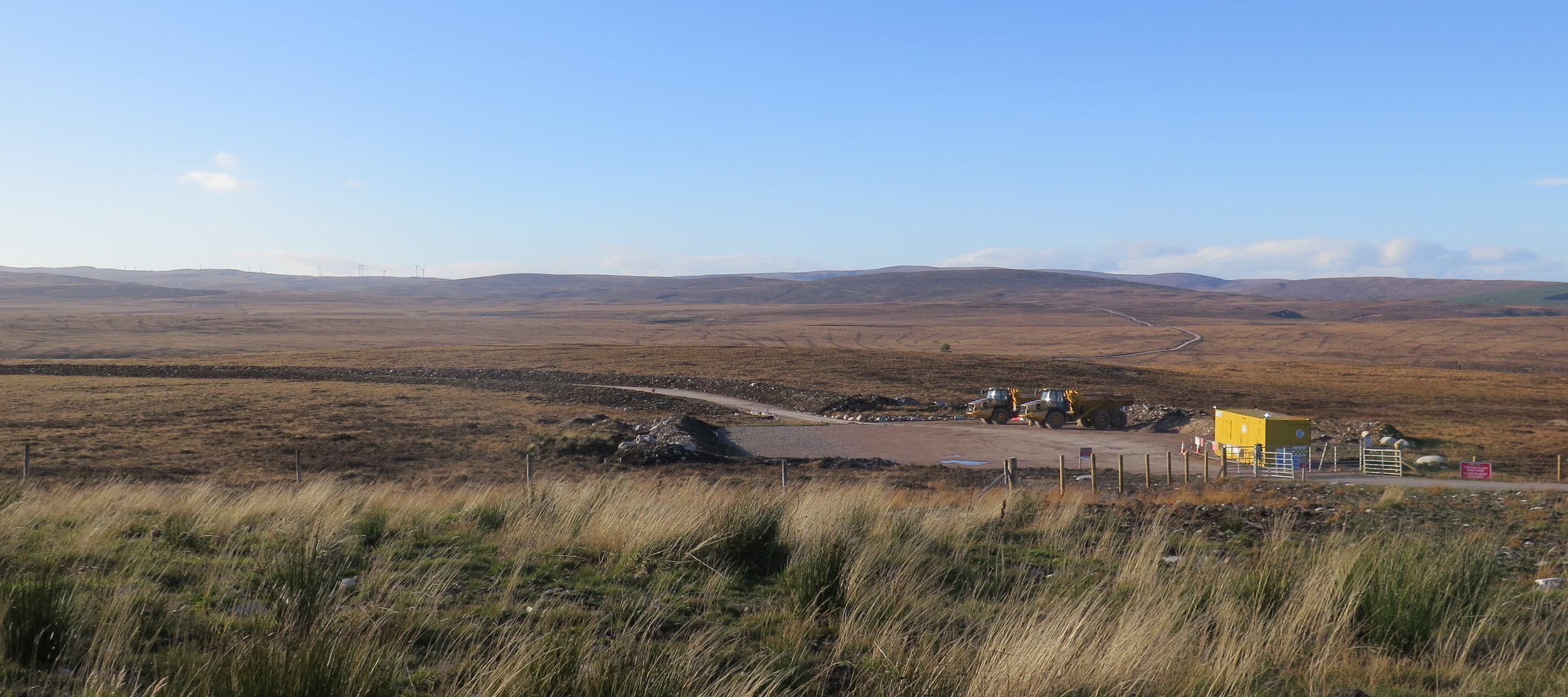Just the start of it for Dava Moor. Further developments, extensions, substations & more roads will soon follow unless we make a stand.

The Wind Business
The simple premise of Renewable Power from Wind Turbines makes sense on the face of it and has to be part of the urgent need to combat climate change - but there are unexpected drawbacks which need to be carefully considered within any properly integrated Energy policy. Its not as simple as creating a forest of Wind Turbines and thinking the job is done but no one seems to have told our Politicians that - or more likely, any intelligent, scientific advice is drowned out by the incessant lobbying of International Developers.
As plans gather pace to develop hundreds of new Turbines in our wild upland areas the victims here, as in many of Scotland’s rural areas, are the communities that live within them. Nowhere is this becoming more stark than in Moray where there is a developer led feeding frenzy to gain Planning Permission for increasing density and numbers Turbines, with the local experience of our Communities and Planners more often than not completely ignored.
Industrial Wind is driven by an alliance of International Developers, local Land Owners, National Politicians & sometimes local Community Councils. The less obvious element is our own inertia, giving the impression of tacit approval, that allows these bodies to get away with the gradual but inexorable destruction of Morays wild landscape. This is where Save Wild Moray hopes to play a part, by presenting the complete picture of what’s in store for Moray, highlighting the massive disconnect between Impact & Benefit on a local level and helping Morays ‘silent majority’ to ensure their views are being properly represented.
Industrial Wind has hijacked the legitimate Renewable Energy debate and distorted it purely for its own commercial purposes. The entire business is coloured by money – much of which comes from our own taxes & utility bills in the greatest transfer of wealth from the poor to the rich in living memory. It’s even coined its own term - Reverse Robin Hood - and its happening all around us.
How the Business Works ….. or rather doesn’t.
The Government in Westminster has signed up to important Carbon reduction targets, without any clear thought or intelligent strategy on how to deliver them. The easy, unthinking option is to carpet the countryside with inefficient & expensive wind turbines linked to distant population areas by a growing network of inefficient & ugly transmission lines. This provides intermittent, unreliable energy at huge expense to the consumer and once the required back up systems are factored in, little benefit to our Environment.
Already being considered dinosaur technology in more enlightened countries, this is the prevailing policy being rolled out by our mostly urban based Scottish Parliamentarians, alongside an automatic obligation for the National Grid to accept electricity as it is generated (which is not necessarily when it is needed) from any built wind farm, with ludicrous Constraint Payments to compensate developers when the Grid is at over capacity. In Moray, with Beatrice Offshore not even complete and Moray Offshore West & Moray Offshore East already in the pipeline, the wind industry’s insatiable greed still seeks more.
The harder option is to drive forward a modern strategy of balanced renewable generating options, located close to the point of demand, controlled by smart grids and sensitive to the local surroundings with an alliance of Communities, Landowners & local Political representatives ensuring benefit & impact remain in careful harmony.
International Developers – most current and proposed developments in Moray are owned by foreign wealth funds and international businesses, including the sovereign wealth fund of China (Gingko Tree), sovereign wealth fund of Sweden (Vatternfall), Stakraft & Fred Olsen of Norway, EON of Germany and EDF of France to name but a few. They rely on a distorted system of indirect benefits including constraint payments that see them incentivised with millions in compensation for the wind blowing too much or too little. Huge sums of cash are involved, ultimately generated from our own taxes & green levies, a tiny fraction of which is fed back to impacted Communities in ad hoc Compensation (or Community Benefit?) payments. You couldn’t make it up - but it’s todays reality!
“I am a young health professional who has recently moved back to Moray where I grew up. I was keen to return to the area as I am particularly fond of its rural appeal, beautiful scenery and its wildlife. I am therefore very disappointed to discover the plans for further large scale wind farms.
Moray is an area that is struggling to attract skilled professionals as it is, and I fear if our countryside is covered in yet further windfarms, dominating the landscape, it will spoil Morays rural charm and countryside appeal. This will further put off young professionals moving to the area, not to mention the knock on effect on the tourism industry and its jobs. ”
Moray Landowners have long struggled to balance the economics of their rural estates and as such have become easily dazzled by the prospect of fast money. In some cases this has seen them allow industrial wind developments to be sited on their ground, more often than not on the far peripheries, where almost the entire impact falls directly on neighbours. The justification is often that valuable revenue is coming to Moray and to the communities around these developments through the payment of adhoc Community benefit schemes. In most cases this amounts to 2 pence per megawatt of energy generated for each of us in Moray. It omits to factor in the real cost from the blight of enormous areas of Moray and the impact that has on sustainable Community wellbeing and the appeal of our Natural Capital to visiting tourists and people & businesses looking to settle in the County.
Community Councils can sometimes find themselves unwitting facilitators of this destruction. Finding it hard to resist the dribble of cash that comes through the Community Benefit Schemes (as & when the developers decide it’s appropriate), they struggle to gauge the genuine sentiment in their local areas and can find themselves drawn in to the process by International Developers seeking to expertly steer around the planning process. Morays landscape is always the loser – and with it all those who live within it. Know your Community Council & contact them directly, leaving them in no doubt as to the local strength of feeling against Industrial Wind in Moray. Check our Object Now page for all relevant links.
“There’s NO FREE LUNCH when it comes to Community Benefit. It exacts a terrible price, guaranteeing the destruction of the very areas we are all responsible for protecting. ”
There are many better alternatives to Industrial Wind
Short term: balance solar / tidal / hydro / heat source / biomass / fusion / local community wind power build good value, sustainable, local capacity.
Long term: create vibrant community energy hubs - generating power at point of demand, balanced by local smart grids. Meeting all local needs for Electricity / Heating & Transport in a benign & sustainable way that preserves the integrity of our Natural Landscape in the process - the very element that we’re all trying to protect.
In Moray terms, the ideal scenario by far is a close collaboration of Communities, Land Owners & Moray Politicians with National level funding support and the expertise of Local Energy Scotland to develop sustainable, integrated & balanced local energy systems.
The Save Wild Moray team can be contacted on: hub@savewildmoray.com
“Scotland is set to become the most overcrowded country on earth for wind turbines.”
DAILY express IN MARCH 2015 - found to be absolutely correct

